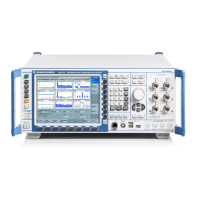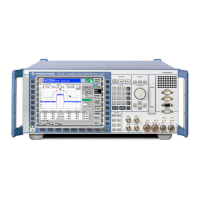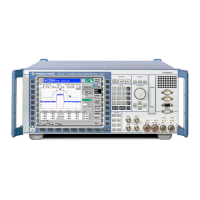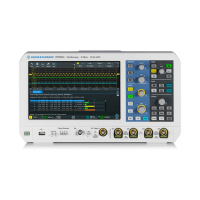System Overview
R&S
®
CMW500
71User Manual 1173.9463.02 ─ 06
Constellation diagrams give a graphical representation of the signal quality and can help
to reveal typical modulation errors causing signal distortions, as shown in the table below.
In practice, the received signal will show a combination of the modulation errors listed.
Modulation error Description / cause Effect in the constellation
diagram
I/Q imbalance Caused by different gains of the I and Q components One of the components is
expanded, the other com-
pressed
I/Q origin offset Caused by an interfering signal at the RF carrier fre-
quency
All constellation points are shif-
ted by the same vector
Interferer Non-coherent single-frequency spurious signal in the
frequency band, superimposed on the modulated sig-
nal
Rotating pointer superimposed
on each constellation point,
causes circular constellation
points
Gaussian noise Uncorrelated interfering signals Fuzzy constellation points
Phase error Phase shift between I and Q components different
from 90 deg
Non-orthogonal I and Q com-
ponents
Phase noise Uncorrelated phase error Rotationally spreading constel-
lation points
Amplitude com-
pression
Large amplitudes below the nominal value, caused by
non-linear components in the transmission path
Corner points move towards
the center
Unused detected
subcarriers (in
OFDMA systems)
An unused/inactive subcarrier is measured, most
likely due to a mismatch between the TX measure-
ment settings and the measured signal
Unexpected constellation
close to the origin (zero signal
power)
3.2.7.6 Multi Evaluation Measurements
In a multi evaluation measurement, the R&S CMW500 acquires a wide range of mea-
surement results at once.
For example, the GSM multi evaluation measurement provides the most important GSM
mobile transmitter test results described in specification 3GPP TS 51.010:
●
The transmitter output power versus time
●
Results that describe the modulation accuracy: Error vector magnitude (EVM), phase
error, frequency error for each symbol, normalized I/Q vector at and between the
decision points (I/Q constellation, vector and phase diagrams)
●
Results that describe the output RF spectrum: adjacent channel power (ACP) due to
modulation and due to switching, ACP versus time
The WiMAX multi evaluation measurement assesses the modulation accuracy, fre-
quency error, power, crest factor, and spectral flatness in the measured burst as descri-
bed in section "Measurement Results" in the description of the "WiMAX measurement"
firmware application.
Compared to independent TX measurements, multi evaluation measurements provide
several advantages:
●
They ensure highest measurement speed.
Measurements
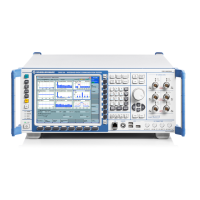
